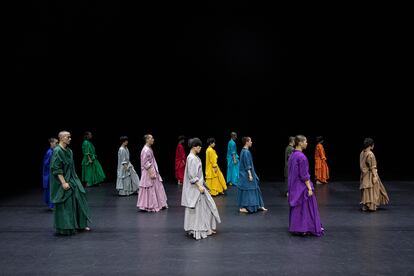There are shows, as there are books, exhibitions, films, etc., that require greater activity on the part of the recipient, in this case, the spectators, to give meaning to the story that is transmitted and reconstructed. That is to say, what we do with what is offered to us requires a greater effort on the part of the person who receives it. In the double program offered last night at the Teatros del Canal in Madrid (today is the last day of performance) by the Chinese company Tao Dance Theater, the effort is to share that meditation through the body that the dancers seem to exercise (12 in the first piece and 14 in the second). They develop the technique of the circular system of movement, which is a methodology sponsored by their choreographer Tao Ye, who directs the company together with the dancer Duan Ni.
The technique is based on taking the spinal column as the main axis and from there, drawing circular movements that, in the body of the performers of this group, result in a precision and even perfection, close to the inexplicable. But this technique is also based, and here comes the part in which a special predisposition is required of us to be able to connect with it, extra doses of concentration, since it rests on continuous repetition. In this sense, the company’s discourse is based on the oriental harmony that permeates Chinese culture, accentuated in both pieces by their soundtracks: ancient sounds signed by the composer Xiao He, in the first, 12; and by the repetitive and tireless resonance of a metronome, in the second, titled 14.
The name of the two pieces also responds to a creative formula coined by Tao Ye in recent years. He has called it “numerical series” and accentuates the abstract nature of these shows titled with numbers (the 14 is the last one) which also refer to the number of dancers on stage. The total absence of a dramaturgy with some touch of narration (although there is no story, in contemporary dance there almost never is), the linearity of what happens on stage and the incessant repetition, are patterns already experienced for decades in dance. and who have given truly extraordinary shows of great contained force. However, despite quite a few very interesting ingredients in this double bill, the evening turned out flat. Too much distance (surely intended) between the stage and the stalls.
They are works that work well with each other. The first, 12, a 30-minute exercise composed of solos on white linoleum, supports his body speech on the floor. Without almost coinciding on the stage, the bodies enter and leave one by one, diagonally, dressed in light colors, executing a chain that could be repeated ad infinitum. 14, The second piece of the night is also a work that could drag on until it finds its end. They are pieces that begin and end without any theatrical lexicon to announce it (no lowering of the lights, no curtain, no absence of music…) and, without a doubt, this is one of the great successes of the two works: finally something of confusion shakes us in the chair.
On some occasion, Tao Ye has stated that in his works the body, and only the body, stripped of any external stimulus, is the protagonist. 12 y 14 They attest to this creed with an amalgamation of almost automaton dancers (without any facial expression) who, even when the applause has started (the greetings also seem to be part of the choreography), do not give any sign of life beyond the dance.

